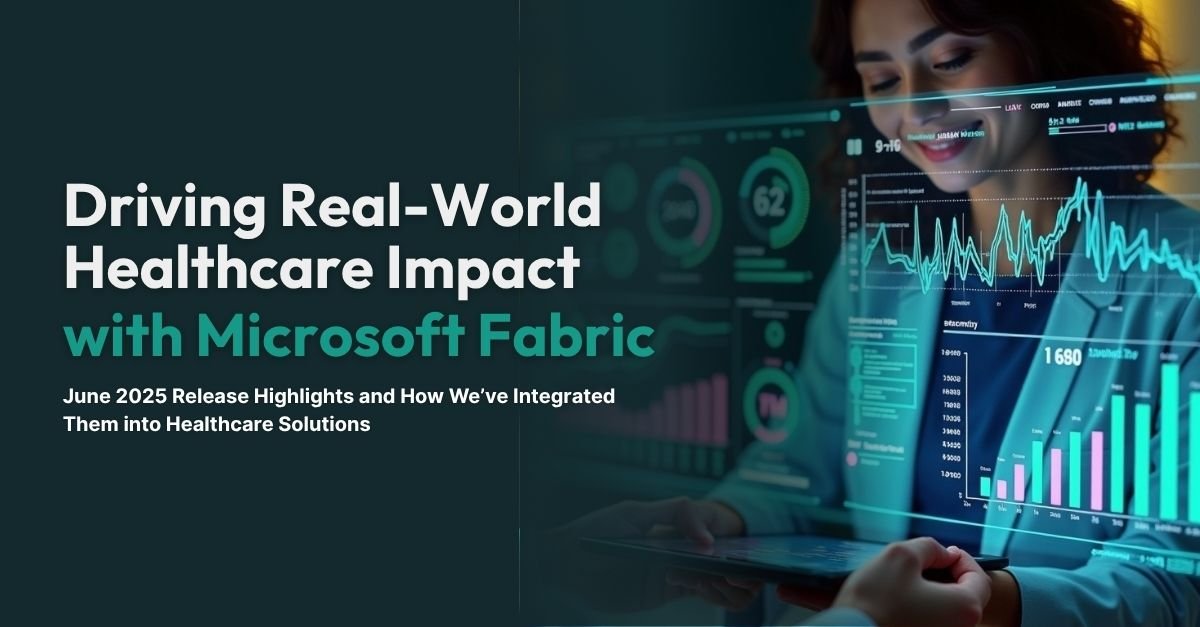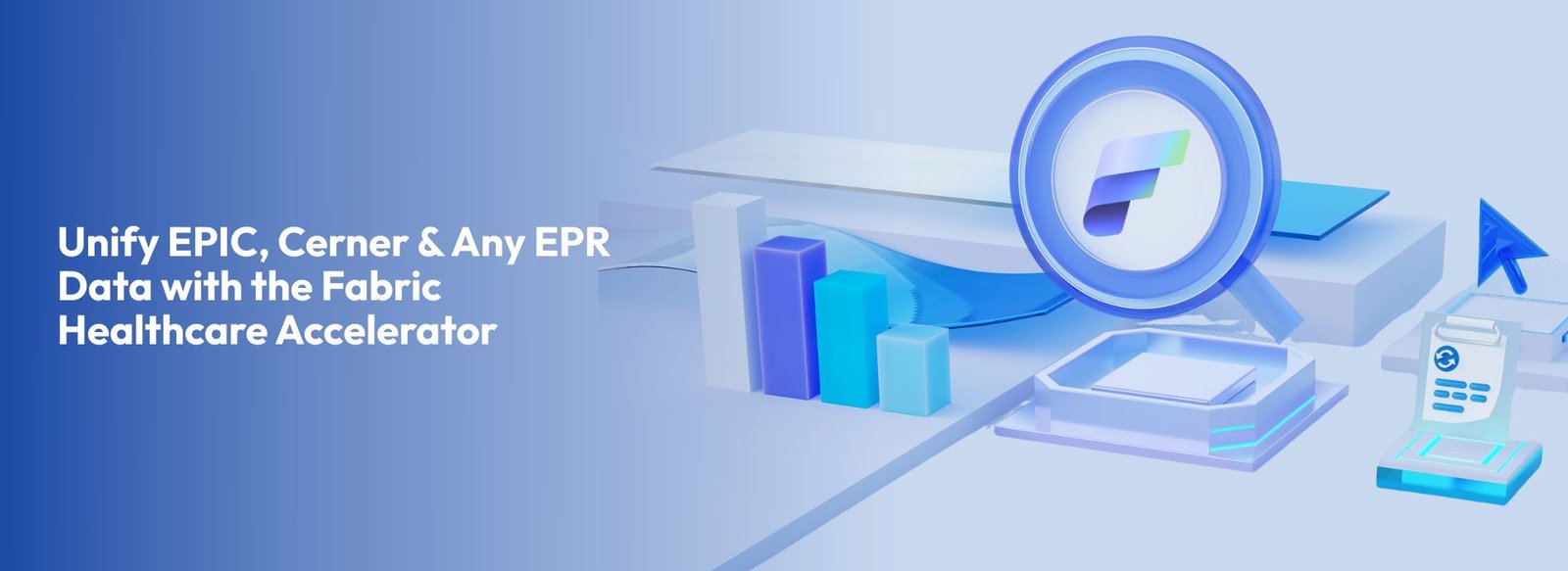Healthcare organisations generate over 50 petabytesz of patient data, clinical reports, and operational metrics annually per hospital, and around 97% of it goes completely unused. The latest Microsoft Fabric updates are designed to change that by simplifying data management. Imagine the possibilities if you could harness all of it, transform loads of data into powerful insights that actually drive care forward. That is the promise behind the latest Microsoft Fabric June 2025 update. It introduced new features that help organisations work with real-time data, bring all their insights together, and make smarter choices. Here is what’s new and why it matters: June 2025 Fabric Updates 1. Notebooks Upgrades Do you ever wish you could manage all your configuration values in one tidy place? With the new variable libraries in Fabric Notebooks (preview), you can. No more hunting down code or redoing setups for each project, just one update, and you are good everywhere. For busy hospital IT teams managing multiple environments, this means less chaos, more control. For speed, the Copilot code completion tool now helps you write Python faster and with fewer errors. That is good news for anyone building or automating healthcare workflows. Less time on code, more time on care. 2. T-SQL and Python Together The age-old problem of clinical and technical teams working in silos, using different tools, speaking different “languages” is now solved. With the new MS fabric update, both T-SQL and Python can run together in the same notebook. Whether you are querying patient data or doing a quick analysis, real collaboration just got a whole lot easier. 3. AI Functions Get a Boost AI in healthcare is here, and it is practical. Fabric now runs AI functions on GPT-4o-mini, right inside the Fabric 1.3 runtime. This simply means better results, lower cost. You can also use these AI features in pandas without needing Spark. For healthcare analysts, that means they can spend less energy wrangling with technical roadblocks and more time actually extracting insights that make a difference. 4. Data Warehouse Performance Imagine running your favourite SELECT queries and getting results in a blink. That is what result set caching (preview) brings to Fabric’s Data Warehouse. For patient outcomes or operational dashboards, the updates are lightning-fast, and delays are a thing of the past. 5. Real-Time Intelligence Improvements From patient monitors to hospital workflows, real-time data is the heartbeat of healthcare. With Eventstream’s new multi-schema support, smarter SQL operators, and streamlined secure ingestion from Azure Event Hubs and IoT Hubs. This means, keeping tabs on everything just got simpler and more reliable. 6. Azure Data Factory Integration Migration headaches, begone. Now you can mount existing ADF pipelines directly into Fabric, without a full rebuild requirement. This is a huge relief for anyone centralising or modernising healthcare data workflows. 7. Power BI Turns 10 A decade of Power BI, and the party is just getting started. With new community events, contests, and even deeper integration with Fabric, data teams can share, explore, and build interactive dashboards faster than ever before. How Mazik Global Uses the New Fabric Features in Healthcare At Mazik Global UK, we see every Microsoft Fabric upgrade as a fresh opportunity to deliver measurable value. We’re already making the most of existing capabilities and we’re fully prepared to embrace the latest features to further support our healthcare clients. 1. Care Coordination Using our MazikCare suite, which includes Care Provider Link and Care Path, we provide real-time visibility into patient plans and care pathways. With the latest Fabric updates, such as Eventstream’s multi-schema support and Copilot-powered KQL queries, we streamline care team workflows even further. Clinicians and care managers now access patients’ real-time data and automated alerts directly within their dashboards, all powered by Fabric’s robust streaming capabilities. 2. Data Unification Bringing data together from different sources is never easy, but our Data Fusion solution makes it possible. We pull in EHRs, lab results, payer feeds, and more into a secure Microsoft Fabric environment. With Fabric’s new variable libraries, connection details are managed in one place, no more hunting for hard-coded values. When it is time to modernise, we move existing Azure Data Factory pipelines straight into Fabric, so all your important business logic comes with you, and day-to-day operations keep humming along. 3. Analytics & AI Velocity Insights, our own solution, makes sure care teams are always in the loop. Vitals, lab updates, and medication changes pop up live on dashboards. When something is off, a vital drifts, or a dose is missed, alerts are sent instantly, with clear, practical recommendations so care teams can step in quickly and confidently. 5. Operational Efficiency We manage your Fabric capacity and Fabric cost through our Azure Management and Data & Analytics services, so you are always running efficiently and never overpaying or under-provisioned. With tools like variable libraries and notebook versioning, our team cuts out manual work. Plus, secure Eventstream endpoints mean patient data stays private and your compliance requirements are always covered. Conclusion With the new June Microsoft Fabric update, it is a real step forward in getting timely, unified, and actionable data into the hands of healthcare teams. At Mazik Global UK l, we are excited to help health systems use these new tools to improve patient outcomes, optimised costs, and work smarter, day in and day out. The future of healthcare is data-driven, and with Microsoft Fabric, that future just got a whole lot brighter. 👉 Start Your 12-Week Data Journey Today Explore how Mazik Global’s Microsoft Fabric Data Solution and Generative AI can help your healthcare organisation achieve smarter data management, faster insights, and better patient outcomes. 🔗 Get started via Microsoft Marketplace
Unify EPIC, Cerner, & Any EPR Data with the Fabric Healthcare Accelerator
Introduction Contemporary healthcare organisations are functioning within an even more sophisticated digital expansion and are dependent upon Electronic Health Records (EHRs) provided by vendors such as Epic, Cerner, and others. These are crucial in-patient care, but the chaotic aspect of them can make the patient care ecosystem more difficult to conduct data analytics, reporting, and collaboration. The Fabric Healthcare Accelerator, built on Microsoft Fabric, will address these challenges and create a seamless method of unifying fragmented EPR data and unlocking its power as the basis of high-level analytics and patient-centred care.Here in this blog, we discuss the working of the Fabric Healthcare Accelerator, its advantages, and why it is such an important tool for healthcare organisations in the year 2025. What is the Fabric Healthcare Accelerator? Fabric Healthcare Accelerator, developed by Mazik Global, is a complex data unification and analytics tool based on Microsoft Fabric. The essence of its action is to integrate, unify, and transmute data from different Electronic Patient Record (EPR) systems, such as EPIC, Cerner, among others, and consolidate it into one actionable data model. This will enable organisations to: Under the strategy, healthcare organisations can attend more to patient outcomes and spend less time reconciling non-integrated sources of data. The Challenge of Disconnected EPR Systems in Healthcare Modern healthcare leaders face immense pressure due to: For many, disconnected EPR systems remain a bottleneck. The result? Incomplete patient records, delayed decision‑making, and fragmented analytics across departments. The Fabric Healthcare Accelerator resolves these issues by providing a common language and framework for patient data across platforms. Why Choose the Fabric Healthcare Accelerator? This solution offers more than just data connectivity: Powered by Microsoft Fabric Backing the Fabric Healthcare Accelerator is Microsoft Fabric, a unified analytics platform proven to deliver exceptional efficiency and cost savings: The benefits will further be augmented with the insertion of the Fabric Healthcare Accelerator, which makes it the most suitable option for the NHS and other healthcare organisations present in the UK. Real-World Impact: An Example The Trust does not have a clinical system or an operations system that subscribes to EPIC and Cerner, respectively. In the past, synchronization of the information was a manual task and an expensive process. Through the launch of the Fabric Healthcare Accelerator, the Trust will be able to: Weighing The Agenda: What You Will Learn in the Webinar Mazik UK and Microsoft are hosting a revealing webinar on how to utilize data in a unified fabric accelerator healthcare platform to integrate EPIC, Cerner, and any EPR data. In this one-hour session, you’ll learn: Date: 3rd July 2025 | Location: Online Webinar | Duration: 1 Hour | Host: Mazik Global UK Webinar Speakers: Why Attend? If your role involves healthcare analytics, digital transformation, or data governance, this webinar is for you. You’ll leave with: An ideal session for ideal for Chief Information Officers (CIOs), Chief Data Officers (CDOs), Business Intelligence (BI) Leads, Healthcare IT Leaders & Data Platform Architects. Conclusion: The way towards a connected and smarter healthcare system relies on the ability to use the fragmented data and make it actionable. Fabric healthcare accelerator does this by connecting data on EPIC, Cerner, and other EPRs, paving the efficient, intelligent, patient-centred care provided by hospitals, NHS Trusts, and clinics. To find out more about how the fabric healthcare accelerator can help achieve better outcomes, improved operational efficiency, and a patient-led approach, please email us now or register to attend the webinar on 3rd July 2025.

















